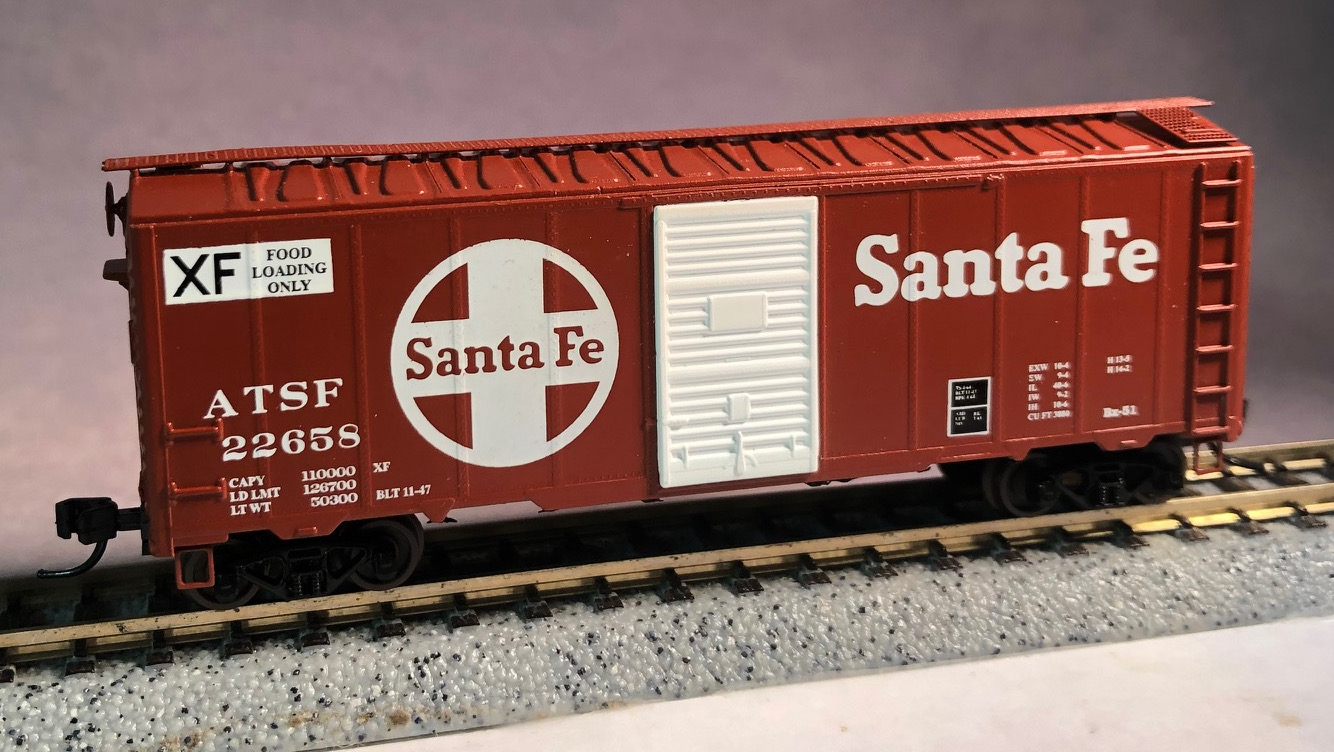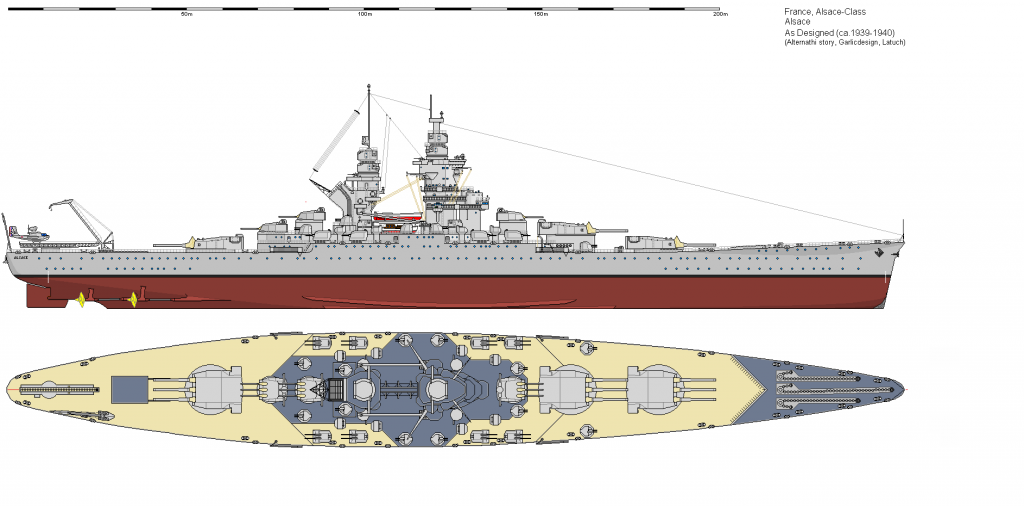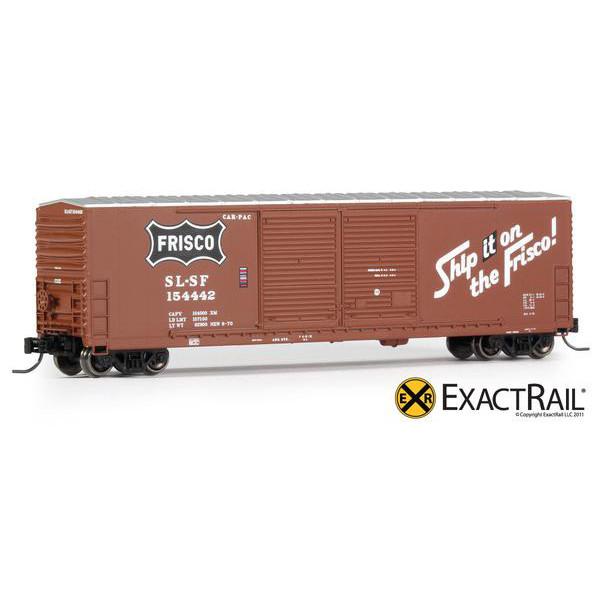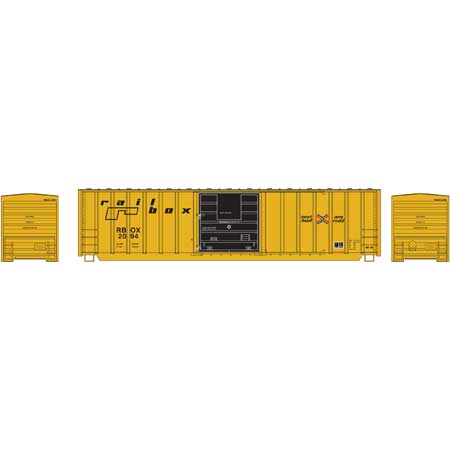Prototype History: The Association of American Railroads had been establishing design standards for freight cars since the early part of the century. Each new design standard meant higher capacity, lighter, more durable cars. The 1937 standard 40' box car featured an interior height of 10'. Just prior to America's entry into the war, there was a push for an even larger interior height for the AAR standard. The first cars that would eventually be termed 1944 AAR, were actually built in 1941 but the war delayed its declaration as the standard. The new taller cars required a new design of end. Corrugated metal ends had been used since the days when wood side cars dominated for a very good reason, shifting loads would burst through wooden ends during sudden starts and stops! These corrugated panels were stamped in two sections, split horizontally down the middle. The 1937 standard had 5 ribs on one half and 4 ribs on the other -- creating what is called a 5-4 Dreadnaught end. The slightly taller 1944 model required something a little different. The lower panel has 4 ribs while the upper panel has 3 then a space and a final rectangular rib at the top. Called a 4-3-1 (or R-3-4) Improved Dreadnaught end, this design would dominate new box car construction for years.
Road Name History: 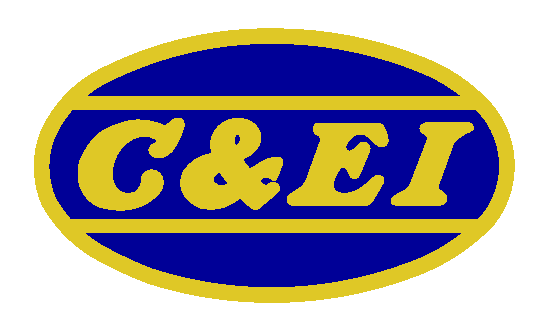 The Chicago & Eastern Illinois was formed in 1877 as a result of the reorganization of the Chicago Danville & Vincennes. By 1902 the C&EI ran south out of Chicago and split into three routes south of Danville, Illinois.
The Chicago & Eastern Illinois was formed in 1877 as a result of the reorganization of the Chicago Danville & Vincennes. By 1902 the C&EI ran south out of Chicago and split into three routes south of Danville, Illinois.
The eastern fork followed the Indiana-Illinois border (on the Indiana side) south to Evansville near the Kentucky border. At Evansville, traffic was primarily handed off to Louisville & Nashville for points in the South. This route saw the lion’s share of C&EI’s passenger business. In fact, many Chicago to Florida passenger limiteds traveled the C&EI from Chicago to Evansville. The Dixie Flagler, for instance, was routed: C&EI, Louisville & Nashville, Nashville Chattanooga & St. Louis, Atlanta Birmingham & Coast, Atlantic Coast Line, and Florida East Coast to get to Miami.
The center fork passed through Salem and Mount Vernon to the southern tip of Illinois, over the Thebes Bridge to Chaffee, Missouri and friendly connections with Cotton Belt, Frisco, and MoPac. This line generated considerable coal traffic in addition to through freight from Chicago to Louisiana and East Texas. Passenger service was provided by The Meadowlark. In later years this train used ACF Motorailers and later still, Budd RDC’s.
The western fork went to St. Louis. However the line from Pana, Illinois to St. Louis was actually on trackage rights with New York Central’s “Big Four” route. Passenger service on this line ended right after WWII due to unbeatable competition from GM&O, IC, and Wabash.
Total system mileage maxed out at about 950, putting C&EI between Lackawanna and Montana Rail Link in relative size. Prior to 1933, C&EI had been controlled by Frisco, then Chesapeake & Ohio (on behalf of the Van Sweringen Brothers.) That year brought another receivership but freed them from control by other lines for more than three decades.
In the 1960s, Louisville & Nashville, Illinois Central and Missouri Pacific dueled for control of the C&EI. In 1967, a compromise was reached. MoPac took control of the C&EI and sold the Evansville line and half interest in the line from Danville to Chicago to the L&N. L&N also received portions of the C&EI diesel and freight car fleets and most of the remaining passenger equipment. The sales to L&N were completed in 1969.
The remaining C&EI diesels were painted MoPac “Jenks Blue” and received buzzsaw logos with “C&EI” within. In 1976, the C&EI was merged into the Missouri Pacific.

The eastern fork followed the Indiana-Illinois border (on the Indiana side) south to Evansville near the Kentucky border. At Evansville, traffic was primarily handed off to Louisville & Nashville for points in the South. This route saw the lion’s share of C&EI’s passenger business. In fact, many Chicago to Florida passenger limiteds traveled the C&EI from Chicago to Evansville. The Dixie Flagler, for instance, was routed: C&EI, Louisville & Nashville, Nashville Chattanooga & St. Louis, Atlanta Birmingham & Coast, Atlantic Coast Line, and Florida East Coast to get to Miami.
The center fork passed through Salem and Mount Vernon to the southern tip of Illinois, over the Thebes Bridge to Chaffee, Missouri and friendly connections with Cotton Belt, Frisco, and MoPac. This line generated considerable coal traffic in addition to through freight from Chicago to Louisiana and East Texas. Passenger service was provided by The Meadowlark. In later years this train used ACF Motorailers and later still, Budd RDC’s.
The western fork went to St. Louis. However the line from Pana, Illinois to St. Louis was actually on trackage rights with New York Central’s “Big Four” route. Passenger service on this line ended right after WWII due to unbeatable competition from GM&O, IC, and Wabash.
Total system mileage maxed out at about 950, putting C&EI between Lackawanna and Montana Rail Link in relative size. Prior to 1933, C&EI had been controlled by Frisco, then Chesapeake & Ohio (on behalf of the Van Sweringen Brothers.) That year brought another receivership but freed them from control by other lines for more than three decades.
In the 1960s, Louisville & Nashville, Illinois Central and Missouri Pacific dueled for control of the C&EI. In 1967, a compromise was reached. MoPac took control of the C&EI and sold the Evansville line and half interest in the line from Danville to Chicago to the L&N. L&N also received portions of the C&EI diesel and freight car fleets and most of the remaining passenger equipment. The sales to L&N were completed in 1969.
The remaining C&EI diesels were painted MoPac “Jenks Blue” and received buzzsaw logos with “C&EI” within. In 1976, the C&EI was merged into the Missouri Pacific.
Brand/Importer Information: DeLuxe Innovations is a "wholesale manufacturer" of model trains. We manufacture scale replica train models and sell them to hobby shops and distributors worldwide. 2013 marked the 20 year anniversary of DeLuxe Innovations brand trains. There are over 25 body styles in our product line and all of the cars in our single and multi-car packs have different road numbers. DeLuxe Innovations, Inc. is owned by Dave Ferrari, founder of Squeak N Products. We are located in Midland Park, New Jersey. When Dave purchased the business it was located in Burbank, California which would have been a bit of a long commute so the move to the East Coast was planned. Our first East Coast location was in Whippany, NJ along the Whippany River.
The business was started in 1993 by George Johnsen and Roberta Liebreich in Burbank, California. They had a philosophy that just wouldn't allow using a coal car as a "stand in" for a woodchip car, or printing any and all boxcar paint schemes on a PS-1. Starting with the release of the first ever etched metal parts for a ready to run car (1994's Twinstack's metal walkways) through the full dimension underframe and etched metal roofwalk (1996's 1944 AAR Boxcar) to the challenging RoadRailer system (2000), our products have been accurate to target the modeler or enthusiast.
You can also follow DeLuxe on Twitter
The business was started in 1993 by George Johnsen and Roberta Liebreich in Burbank, California. They had a philosophy that just wouldn't allow using a coal car as a "stand in" for a woodchip car, or printing any and all boxcar paint schemes on a PS-1. Starting with the release of the first ever etched metal parts for a ready to run car (1994's Twinstack's metal walkways) through the full dimension underframe and etched metal roofwalk (1996's 1944 AAR Boxcar) to the challenging RoadRailer system (2000), our products have been accurate to target the modeler or enthusiast.
You can also follow DeLuxe on Twitter
Item created by: Powderman on 2018-12-21 18:04:35. Last edited by gdm on 2020-07-24 07:29:20
If you see errors or missing data in this entry, please feel free to log in and edit it. Anyone with a Gmail account can log in instantly.
If you see errors or missing data in this entry, please feel free to log in and edit it. Anyone with a Gmail account can log in instantly.


